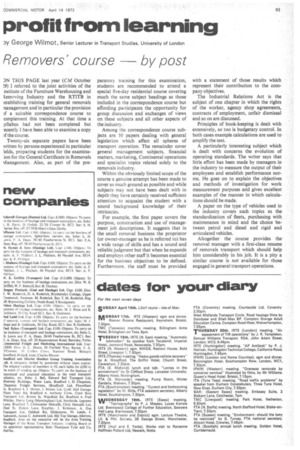profit from learning
Page 95

If you've noticed an error in this article please click here to report it so we can fix it.
Dy George Wilmot, Senior Lecturer in Transport Studies, University of London
Removers' course by post
3/N1 THIS PAGE last year (CM October '.9) I referred to the joint activities of the .nstitute of the Furniture Warehousing and Zemoving Industry and the RTITB in :stablishing training for general removals nanagement and in particular the provision )f a suitable correspondence course to :omplement this training. At that time a lyllabus had not been completed but .ecently 1 have been able to examine a copy A' the course.
Twenty-six separate papers have been written by persons experienced in particular kids, preparing students for the examineion for the General Certificate in Removals Vlanagement. Also, as part of the pre
paratory training for this examination, students are recommended to attend a special five-day residential course covering much the same subject headings as those included in the correspondence course but affording participants the opportunity for group discussion and exchanges of views on these subjects and all other aspects of the industry.
Among the correspondence course subjects are 10 papers dealing with general legislation which affect all spheres of transport operation. The remainder cover general management subjects, financial matters, marketing, Continental operations and specialist topics related solely to the removals industry.
Within the obviously limited scope of the course a genuine attempt has been made to cover as much ground as possible and while subjects may not have been dealt with in depth they have certainly received sufficient attention to acquaint the student with a sound background knowledge of their intricacies.
For example, the first paper covers the purpose, construction and use of management job descriptions. It suggests that in the small removal business the proprietor (or owner-manager as he is referred to) has a wide range of skills and has a sound and reliable judgment but that when he expands and employs other staff it becomes essential for the business objectives to be defined. Furthermore, the staff must be provided with a statement of those results which represent their contribution to the company objectives.
The Industrial Relations Act is the subject of one chapter in which the rights of the worker, agency shop agreements, contracts of employment, unfair dismissal and so on are discussed.
Principles of book-keeping is dealt with extensively, so too is budgetary control. In both cases example calculations are used to amplify the text.
A particularly interesting subject which is dealt with concerns the evolution of operating standards. The writer says that little effort has been made by managers in the industry to measure the output of their employees and establish performance norms. He goes on to explain the objectives and methods of investigation for work measurement purposes arid gives excellent examples of the manner in which calculations should be made.
A paper on the type of vehicles used in the industry covers such topics as the standardization of fleets, purchasing with maintenance in mind and the choice between petrol and diesel and rigid and articulated vehicles.
Altogether the course provides the removal manager with a first-class resume of removals transport which should help him considerably in his job. It is a pity a similar course is not available for those engaged in general transport operations.




















































































































































